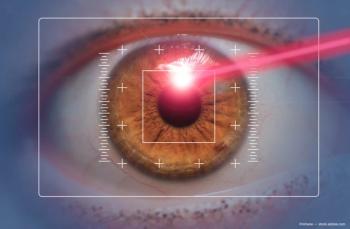
Localized RNFL thinning helps in differential diagnosis
Fort Lauderdale, FL-Key findings in the optic disc and retina may make it possible for clinicians using optical coherence tomography (OCT) to distinguish between early glaucoma and optic neuropathy in patients with mild Alzheimer's disease.
A recent study indicated that patients with early glaucoma had optic disc cupping and localized thinning of the inferior retinal nerve fiber layer (RNFL). Patients with Alzheimer's disease characterized by mild dementia had normal cup-to-disc ratios and localized RNFL thinning in the superior quadrant. These results may be important indices for the early diagnosis of Alzheimer's disease, according to Fatmire Berisha, MD, who presented the findings of her group at the annual meeting of the Association for Research in Vision and Ophthalmology.
RNFL thickness measurements obtained using OCT have important implications for the diagnosis and progression of glaucoma, said Dr. Berisha, a research fellow at Schepens Retina Associates Foundation, Harvard Medical School, Boston. Evidence suggests that visual disturbances in patients with Alzheimer's disease may be the result of primary involvement of the visual pathways, including the retina and optic nerve, in addition to the well-known higher cortical impairment in the brain.
Based on this, Dr. Berisha and her colleagues conducted a study to attempt to characterize differences in the RNFL thickness between patients with early glaucoma and those with mild Alzheimer's disease.
Twelve patients with Alzheimer's disease characterized by mild dementia (mean age, 76.4 ± 4.9 years), 10 patients with early glaucoma (mean age, 74.1 ± 6.4 years), and 10 age-matched controls (mean age, 73.3 ± 5.8 years) were included in this study. The mild dementia in the Alzheimer's patients was based on the Mini Mental State Examination (MMSE) score (mean MMSE score, 24.2 out of a maximum 30).
RNFL thickness comparison
The RNFL thickness and optic nerve head (ONH) parameters were measured using the Stratus OCT. Average and segmental (four quadrants) RNFL thickness values were compared among the three groups using ANOVA with post hoc tests.
The investigators found that the visual acuity was significantly decreased in the patients with Alzheimer's disease (mean, 20/32; range, 20/20 to 20/50; p = 0.01), but not in the patients with glaucoma (mean, 20/26; range, 20/20 to 20/40) compared with the controls (mean, 20/23; range, 20/15 to 20/30). No significant differences were found among the three groups in the IOP values.
"In the current study, patients with glaucoma had significantly increased vertical and horizontal cup-to-disc ratios compared with both the patients with Alzheimer's disease (p <0.01) and the controls (p <0.001)," she explained. "No significant differences in the ONH parameters were found between the patients with Alzheimer's disease and the healthy controls. The average RNFL thickness values were lower in patients with glaucoma (p = 0.05) and patients with Alzheimer's disease (p = 0.016) compared with the controls. No difference was found in the average RNFL thickness between the patients with glaucoma and the patients with Alzheimer's disease.
Newsletter
Don’t miss out—get Ophthalmology Times updates on the latest clinical advancements and expert interviews, straight to your inbox.
















































.png)


